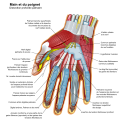Datoteka:Wrist and hand deeper palmar dissection-numbers.svg

Veličina ovog PNG prikaza ove SVG datoteke: 474 × 600 piksela. Ostale razlučivosti: 190 × 240 piksela | 379 × 480 piksela | 607 × 768 piksela | 809 × 1.024 piksela | 1.619 × 2.048 piksela | 555 × 702 piksela.
Vidi sliku u punoj veličini (SVG datoteka, nominalno 555 × 702 piksela, veličina datoteke: 207 KB)
Povijest datoteke
Kliknite na datum/vrijeme kako biste vidjeli datoteku kakva je tada bila.
| Datum/Vrijeme | Minijatura | Dimenzije | Suradnik | Komentar | |
|---|---|---|---|---|---|
| sadašnja | 19:15, 1. lipnja 2015. |  | 555 × 702 (207 KB) | Perhelion | optimize image |
| 13:42, 8. srpnja 2012. |  | 555 × 702 (399 KB) | Wilfredor | optimize image | |
| 23:11, 13. siječnja 2009. |  | 555 × 702 (817 KB) | Wilfredor | {{Information |Description= |Source= |Date= |Author= |Permission= |other_versions= }} | |
| 18:37, 16. listopada 2008. |  | 555 × 702 (815 KB) | Wilfredor | {{Information |Description= |Source= |Date= |Author= |Permission= |other_versions= }} | |
| 21:33, 23. srpnja 2008. |  | 770 × 767 (822 KB) | Bibi Saint-Pol | {{Created with Inkscape}} == {{int:filedesc}} == {{Information |Description= {{en|The hands (med./lat.: manus, pl. manūs) are the two intricate, prehensile, multi-fingered body parts normally located at the end of each arm of a human or other primate. Th |
Uporaba datoteke
Na ovu sliku vode poveznice sa sljedećih stranica:
Globalna uporaba datoteke
Sljedeći wikiji rabe ovu datoteku:
- Uporaba na af.wikipedia.org
- Uporaba na ar.wikipedia.org
- Uporaba na az.wikipedia.org
- Uporaba na bjn.wikipedia.org
- Uporaba na bn.wikipedia.org
- Uporaba na br.wikipedia.org
- Uporaba na ce.wikipedia.org
- Uporaba na crh.wikipedia.org
- Uporaba na cv.wikipedia.org
- Uporaba na da.wikipedia.org
- Uporaba na de.wikipedia.org
- Uporaba na en.wikipedia.org
- Wikipedia:Featured picture candidates/Wrist and hand deeper palmar dissection-en.svg
- Wikipedia:Featured picture candidates/April-2009
- User:Madhero88/Medicalg
- Wikipedia:WikiProject Anatomy/Resources
- Wikipedia talk:WikiProject Anatomy/Archive 9
- User talk:Rhododendrites/Reconsidering FPC on the English Wikipedia
- Uporaba na es.wikipedia.org
- Uporaba na fa.wikipedia.org
- Uporaba na fr.wikipedia.org
- Uporaba na hu.wikipedia.org
- Uporaba na id.wikipedia.org
- Uporaba na incubator.wikimedia.org
- Uporaba na iu.wikipedia.org
- Uporaba na ko.wikipedia.org
- Uporaba na lbe.wikipedia.org
- Uporaba na lb.wikipedia.org
- Uporaba na lt.wikipedia.org
- Uporaba na ms.wikipedia.org
- Uporaba na nia.wiktionary.org
- Uporaba na os.wikipedia.org
- Uporaba na pl.wikipedia.org
- Uporaba na pt.wikipedia.org
- Uporaba na ru.wikipedia.org
- Uporaba na ru.wikimedia.org
- Uporaba na ru.wikinews.org
- Uporaba na ru.wiktionary.org
Pogledajte globalnu uporabu ove datoteke.







